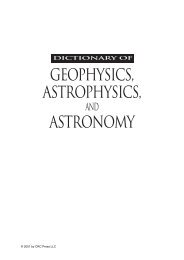tc dokuz eylül university institute of social sciences translation and ...
tc dokuz eylül university institute of social sciences translation and ...
tc dokuz eylül university institute of social sciences translation and ...
You also want an ePaper? Increase the reach of your titles
YUMPU automatically turns print PDFs into web optimized ePapers that Google loves.
hair, hare (Webster's). This is a second major type <strong>of</strong> wordplay. The formal similarity<br />
is weaker than in homonymy but still strong enough for the two words to be related<br />
to each other in the mind <strong>of</strong> the listener or reader (de Vries & Verheij, 1997; 76).<br />
The last form is polysemy which refers to different but related senses for one<br />
word. It is generally agreed that in each case only one word is being discussed, not<br />
two that happen to have the same form (to which the name homonym is given).<br />
Senses <strong>of</strong> the same word are seldom ambiguous in context, but the less specific the<br />
context, the greater the possibility <strong>of</strong> ambiguity. From a theoretical perspective, the<br />
distinction between homonymy <strong>and</strong> polysemy (the repetition <strong>of</strong> the same word in<br />
different meanings) is in many cases difficult to make. “There is an extensive grey<br />
area between the concepts <strong>of</strong> polysemy <strong>and</strong> homonymy. A word like walk is<br />
polysemous (went walking, went for a walk, walk the dog, Meadow Walk Drive),<br />
while a word like bank is homonymous between at least bank for money <strong>and</strong> bank <strong>of</strong><br />
a river” (ww.wordfiles.info). “Only if the words concerned show some semantic<br />
overlap will there be a pun, as wordplay in these cases hinged on the interaction<br />
between similarity <strong>and</strong> difference. To the extent that words in the <strong>translation</strong> show<br />
comparable overlap, there will be a pun-to-pun rendering” (de Vries & Verheij,<br />
1997; 72).<br />
Along with the forms listed above, the other two literary forms can also be<br />
considered as they have to do with a play on words. One <strong>of</strong> these is malapropism -<br />
substitution <strong>of</strong> "fancy" or "pompous" words, <strong>of</strong>ten opposite to the intended meanings<br />
or meaningless, for a correct word, a malapropism (from French mal à propos, "ill to<br />
purpose") is an incorrect usage <strong>of</strong> a word, usually with comic effect. The term<br />
malapropism comes from the name <strong>of</strong> Mrs. Malaprop, a character in Richard<br />
Brinsley Sheridan's comedy, The Rivals, whose name was in turn derived from the<br />
existing English word malapropos, meaning 'inappropriately'. Malapropism is<br />
demonstrated in the following examples: "He's as headstrong as an allegory on the<br />
banks <strong>of</strong> the Nile (i.e., alligator), "He is the very pineapple <strong>of</strong> politeness". (i.e.,<br />
pinnacle) (www.malapropism.co.uk).<br />
10
















